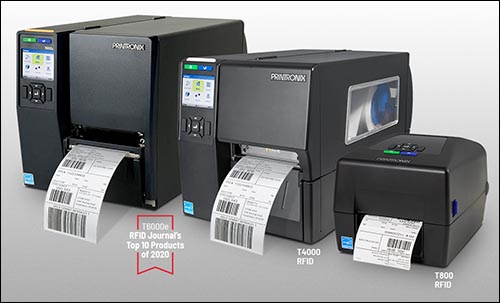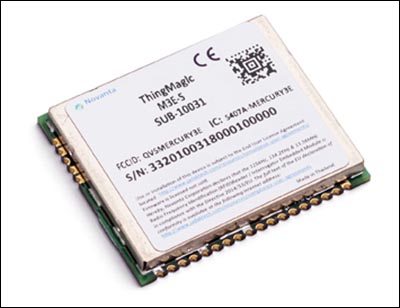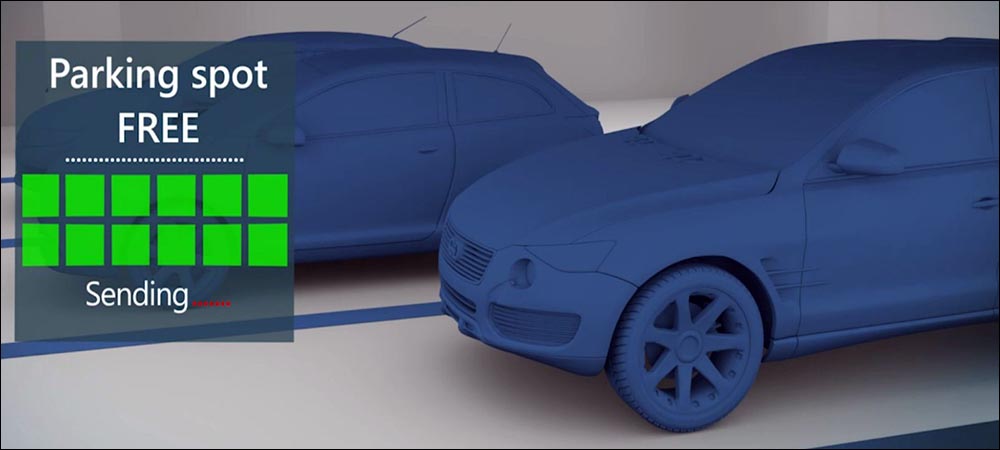Nov 19, 2020Presented here are recent news announcements regarding the following organizations: TSC Printronix Auto ID, STMicroelectronics, Qualcomm Technologies, JADAK, the LoRa Alliance, 1oT, TeamViewer, Teltonika Networks, the AMANDA Stakeholder Group, and NiceLabel.
TSC Printronix Auto ID Upgrades RFID-Barcode Label Printers
TSC Printronix Auto ID, a provider of barcode label printing solutions, has announced the launch of its upgraded RFID printer lineup with expanded printing and encoding capabilities. The product update applies to the company's T800, T4000 and T6000e RFID printers, which can accommodate desktop and industrial printing needs for mainstream, standard and on-metal RFID labels and tags, with footprints ranging from 4 to 6 inches and print resolutions of 203, 300 and 600 dpi.
The printer lineup now includes high-speed encoding, high-memory encoding and RFID upgrade kits. Customers can print and encode labels in seconds, the company reports, and can store product data directly with an item rather than in a remote database. The RFID upgrade kits, compatible with the T4000 and T6000e models, allow customers to turn standard printers into RFID printers. The tags are intended to ensure operational visibility on high-value assets and are suitable for monitoring such items as IT equipment, production tools and parts marking in the automotive and aviation industry.

"This latest release of high-performance encoding speeds gives customers confidence that the printing and encoding process will not impact their operational productivity," said Andy Edwards, Printronix Auto ID's director of product management, in a prepared statement. "The expanded RFID upgrade kits further protects our customer's investment by enabling a path for RFID printing and encoding should they decide on an RFID initiative at a later date."
With RFID technology becoming more widely used for asset tracking and supply chain visibility, this update is intended for customers seeking real-time traceability and edge analytics regarding their inventory, according to Printronix Auto ID. The firm has reduced the list price for each printer. For certain large-bid projects, particularly in government, compliance regulations require that barcode label printers be capable of being upgraded to RFID. Printronix Auto ID's RFID printers meet those requirements, the company reports.
STMicroelectronics, Qualcomm Partner on IoT Sensor Solutions
Semiconductor company STMicroelectronics has developed software solutions using technology from Qualcomm Technologies through the Qualcomm Platform Solutions Ecosystem program. ST is contributing pre-validated software to OEMs for its MEMS and other sensing devices to deliver features for smartphones, connected PCs, the Internet of Things and wearables. Qualcomm has pre-selected ST's iNEMO LSM6DST motion-tracking IC with intelligent sensor software, along with its pressure sensor, for use in its 5G mobile reference platforms.
The iNEMO LSM6DST is a six-axis inertial measurement unit that integrates a three-axis digital accelerometer and a three-axis gyroscope. With power consumption of 0.55mA in high-performance mode and as little as 4mA in accelerometer-only mode, it enables accurate, always-on motion tracking, the company reports. In tandem with ST's low-noise (0.65Pa), high-accuracy (±0.5hPa), I3C-enabled LPS22HH pressure sensor, it provides accurate location tracking while meeting restrictive power budgets.
For imaging applications, the LSM6DST supports electronic and optical image stabilization, as the module includes a dedicated signal processing path for OIS and auxiliary SPI, configurable for both the gyroscope and the accelerometer. In turn, the auxiliary SPI and primary interface can configure the OIS. The LSM6DST supports integration in low-power circuit designs and offers I2C, MIPI I3C or SPI from the sensing element to the application. It contains a 9-kilobyte FIFO to allow dynamic data batching and 16 finite state machines that recognize programmed data sequences from the sensor and further reduce system-level power consumption.
"ST has long recognized the importance of sensors in Qualcomm Technologies' solutions and has been a strong collaborator for many years. They have demonstrated leadership in sensors with new interfaces such as MIPI I3C along with the ability to squeeze the power budget on its devices while maintaining or increasing sensor accuracy," said Manvinder Singh, Qualcomm's VP of product management, in a prepared statement. "We are pleased to have ST join our Qualcomm Platform Solutions Ecosystem program to integrate and optimize their advanced sensor algorithms on the always-on, low-power island of our Qualcomm Snapdragon Mobile Platforms. Collaboration with strategic vendors such as ST is critical to enabling the fast adoption of 5G technologies in different verticals."
"Having worked closely with Qualcomm Technologies for many years, we've been able to assure sensor performance that meets the demanding requirements of next-generation mobile and wearable devices and software solutions that can be used with the Qualcomm Sensor Execution Environment," said Andrea Onetti, the group VP and general manager of ST's MEMS Sensor Division, in the prepared statement. "These include advanced features, such as hinge- or fold-angle detection for smartphones and Mobile PCs, and enable the seamless integration and faster time-to-market of these features that customers across the globe require. Combining the industry's lowest-power high-accuracy IMU with our high-precision, robust, and extremely stable-over-time-and-temperature pressure sensor, can enable the best possible location accuracy to meet e911 and eCall requirements."
JADAK Releases Secure RFID Module for Medical Use
JADAK, a business unit of Novanta, has announce the release of its ThingMagic M3e LF/HF RFID Secure Module, capable of reading iClass and Prox encrypted badges in medical devices. Part of the JADAK Secure Access family of products, the M3e was developed in partnership with HID Global and is enabled with HID's HF and LF RFID protocols, including HID Seos and iCLASS, as well as NXP and EM Microelectronic tags. Jadak will work closely with OEM manufacturers to embed the module in medical devices sold to hospitals and healthcare systems.
The M3e module comes with an integrated secure access module, plus an integrated circuit that handles secure communications and manages security keys required to access more than just the publicly available information on an RFID tag. When embedded in medical devices, the module allows clinicians to use their iClass or Prox badges for secure user authentication and access to devices.

The M3e module will allow healthcare facilities to adhere to guidelines from the FDA and the Health Care Industry Cybersecurity Task Force requiring strong authentication by protecting patient information, ensuring that only authorized users can access medical devices, and maintaining electronic records of staff members who have accessed a given device, interacted with patients or administered medications. Additional benefits include simplified workflows, time efficiencies and infection control, since clinicians can quickly tap their ID badge to log into devices instead of using a password or other methods that can spread infection and add time to the clinical workflow.
"We're proud to partner with HID Global to develop a completely integrated secure access module," said Harinath Reddy, JADAK's senior R&D director for RFID, in a prepared statement. "Healthcare environments are under extreme pressure to increase the level of security and user authentication protocols within their facilities. The M3e helps them to adhere to these stringent security guidelines while also utilizing their existing or planned iClass or Prox encrypted badge protocol."
LoRa Alliance Publishes Latest LoRaWAN IoT Regional Parameters
The LoRa Alliance, a global association of companies backing the open LoRaWAN standard for Internet of Things (IoT) low-power wide-area networks (LPWANs), has announced the release of Regional Parameters RP2-1.0.2, which includes support for all versions of the LoRaWAN Layer 2 Specification. Support of LoRaWAN operation in Senegal, Montserrat, Mali, Guinea, Syria and Vanuatu has been identified, with the RP now supporting more than 200 countries and regions globally.
One major change to the Regional Parameters is the addition of support for new Long-Range Frequency-Hopping Spread Spectrum (LR-FHSS) data rates for the EU868, US915 and AU915 regions. The use of LR-FHSS data rates is optional and preserves backward compatibility with all previous revisions of the RP specification.
LoRaWAN's low power consumption is maintained with the LR-FHSS rates, while network capacity is increased in certain scenarios compared to standard data rates, allowing increased scale on the same network footprint. The company predicts that deployment and management costs of networks will decrease due to this capability, since not as many gateways will be needed. The new rates feature high interference resistance and high spectral efficiency.
"This new set of Regional Parameter Specifications represents our ongoing evolution of the LoRaWAN standard," said Donna Moore, CEO and chairwoman of the LoRa Alliance, in a prepared statement. "The changes augment LoRaWAN's strong support of applications requiring extreme barrier penetration, such as smart buildings and certain smart city applications like parking, as well as greatly improving scalability across a wide range of IoT use cases. Additionally, when used in conjunction with satellite-based networks, they can provide worldwide LoRaWAN coverage and roaming. These benefits will accelerate LoRaWAN deployments globally."
1oT Partners with TeamViewer, Teltonika Networks
Internet of Things connectivity provider 1oT has partnered with TeamViewer, a provider of secure remote connectivity solutions, to bring location-independent secure connections to every IoT device in more than 190 countries. The collaboration enables customers to make devices accessible via a SIM-based data connection, and to control, manage and maintain it with TeamViewer's secure solution. Managing IoT devices that are mobile or located outside of a factory can be challenging due to a lack of an Ethernet cable, the company reports. The two companies agreed to collaborate and offer their services to customers either via TeamViewer's or 1oT's sales departments.
1oT can establish reliable connections from 2G onwards, the company reports, which is available almost everywhere a cell phone can connect. Its eSIM enables the swapping of telecoms over the air wherever needed, without users having to replace the SIM card inside their devices. The solution enables a reliable and secure connectivity to devices in order to read sensor data, visualize it on a dashboard, issue alarms if certain thresholds are reached and put a conditional rule engine in place. This helps technical support to access and control connected devices, according to the company, and to leverage AI-based predictive maintenance features to prevent most downtimes before they even occur.

"1oT is a strong and relevant partner as it enables us to offer our proven IoT solution for even more devices, especially if they are remote and mobile," said Lukas Baur, TeamViewer's VP of IoT, in a prepared statement. "Our IoT product is already used in the factory for static machinery, but 1oT is adding a whole range of opportunities for devices that are in the field and have to be monitored and maintained on a constant basis in order to be profitable."
"To run a successful IoT service at scale, one needs to manage its SIMs and connectivity from one and control its devices from another platform," added Märt Kroodo, 1oT's founder and CEO, in the prepared statement. "I'm happy to announce that 1oT and TeamViewer combine those two platforms into one strong offering, enabling the IoT service provider to focus on its core business. Our offerings complement each other's services and add tons of value to the booming IoT sector together."
In addition, 1oT has partnered with Teltonika Networks to provide the IoT industry with a cellular connectivity solution. "We are combining 1oT eSIM and connectivity management with Teltonika Networks' IoT devices," the company explained in a separate prepared statement. "Teltonika Networks is an expanding technology company that produces professional network connectivity equipment. Teltonika Networks has developed an extensive portfolio of products for the most complex areas of Industry 4.0, smart city and green energy."
The purpose of the partnership is to provide IoT businesses with off-the-shelf eSIM-enabled products. Teltonika Networks oversees product development, while 1oT's flexible eSIM is intended to help businesses launch their projects. 1oT has tested Teltonika's RUT240 and TRM240 devices and has verified them as being compatible with the eSIM architecture.
The RUT240, an industrial 4G LTE Wi-Fi router for M2M and IoT applications, provides high performance for cellular communication in rigorous environments. It is widely used for 4G backup, remote connection, VPN and tunneling services in IoT networking solutions. The TRM240 is an industrial-grade cellular LTE Cat-1 modem with aluminum housing. It is suitable for largescale connectivity upgrades for industrial or public infrastructures since it is backward-compatible with 3G and 2G, the company reports, and it offers a long, stable lifecycle and low power consumption for IIoT projects.
AMANDA Stakeholder Group Develops Autonomous Smart Cards
The AMANDA Stakeholder Group has launched a project to develop an Autonomous Smart Sensing Card (ASSC) with the size, feel and look of a credit card. The ASSC is suitable for deployment in buildings (smart living environments) or as wearables (bicycles, valuable assets and individuals). The project involves autonomous, self-powered, miniaturized intelligent environmental sensing and asset tracking technologies for smart IoT environments.
The AMANDA project covers experimentation, development and standardization, enabling users to improve an applied material's connectivity, miniaturization, power consumption, security, intelligence, design and cost. AMANDA's partners have expertise in manufacturing and infrastructure, as well as with using micro-technology and nanotechnology, new composites, and various types of architectures and software.

The consortium comprises eight partners and is led by the Centre for Research and Technology-Hellas (CERTH). The other partners are Imec Netherlands, the ZHAW Zurich University of Applied Sciences, Lightricity, e-peas, Ilika, Microdul and Penta. The AMANDA project has received funding from the European Union's Horizon 2020 research and innovation program, under grant agreement #825464.
To increase the scientific and commercial impacts of the AMANDA project with external stakeholders, the consortium is currently in the process of setting up an external stakeholder group. The goal of this group is to enable an easy communication channel for the consortium to its external stakeholders, as well as the other way around.
Members of the stakeholder group can opt in to receive a combination of AMANDA collaterals, technical spec sheets, partner contact details, a bi-yearly newsletter and/or a list of AMANDA-specific scientific publications written by AMANDA's partners. The newsletters will include such items as the project's overall status, target use cases and highlights of specific technology from the partners, as well as an agenda listing upcoming events.
NiceLabel Launches Public Cloud Solution for Regulated Companies
NiceLabel, a developer of label design software and label-management systems, has introduced Label Cloud Compliance, a public, validation-ready cloud labeling solution designed to help organizations manage labeling in a regulated environment. Label Cloud Compliance was created to enable companies in regulated industries to comply with the major regulations that impact the life sciences industry, such as FDA UDI, EU MDR, FDA 21 CFR Part 11 and EU GMP Annex 11.
Regulated companies have a focus on quality assurance, compliance with regulations and maintaining a validated system, NiceLabel explains, noting that Label Cloud Compliance was thus designed to give life sciences companies a labeling solution tailored to meet these specific needs. The solution digitizes the quality-approval process and features a three-tier environment that includes development, quality assurance and production environments, with a 12-year print history. Label Cloud Compliance comes with a Validation Acceleration Pack that includes installation qualification reports for all new features and simplifies alignment with industry standards by helping companies implement and maintain a validated labeling solution.
"We can onboard a new customer onto Label Cloud Compliance in minutes, and we also make it very simple to do the initial validation and then update that validation every year as required," said Ken Moir, NiceLabel's VP of marketing, in a prepared statement. "As a multi-tenant cloud solution, Label Cloud Compliance gives companies of all sizes the benefits of a professional label management solution with a much lower total cost of ownership."
In addition, NiceLabel has introduced Version 2019.3 of its label-management solutions portfolio. This new software update is intended to enable organizations to use a single platform for designing and printing labels and supply chain documents, thereby saving them time and money while streamlining their production process.

